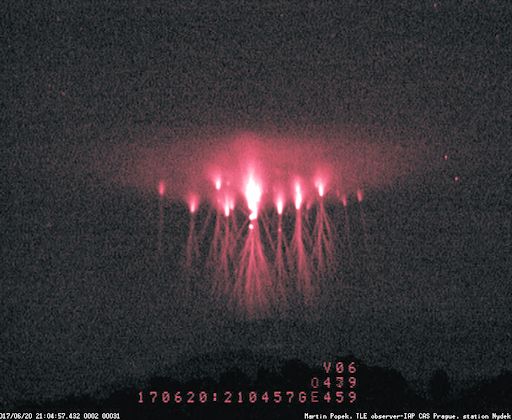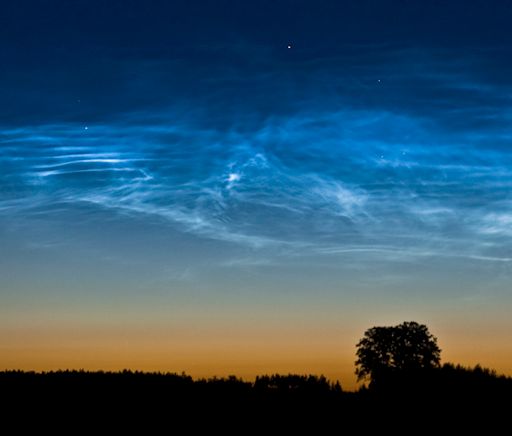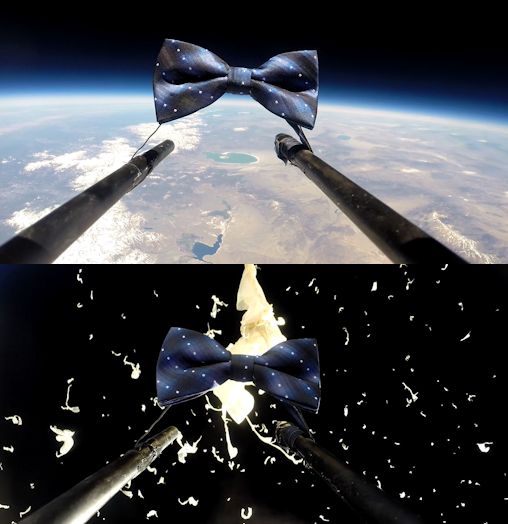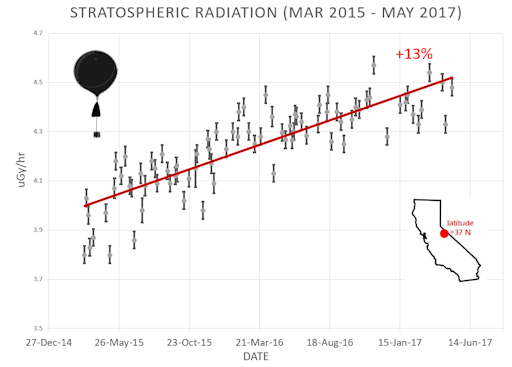 | | | Switch to: Europe, USA, New Zealand, Antarctica Credit: NOAA/Ovation  Planetary K-index Planetary K-index
Now: Kp= 2 quiet
24-hr max: Kp= 2 quiet
explanation | more data
Interplanetary Mag. Field
Btotal: 7.5 nT
Bz: 3.7 nT north
more data: ACE, DSCOVR
Updated: Today at 2349 UT  Coronal Holes: 23 Jun 17 Coronal Holes: 23 Jun 17 
Solar wind flowing from the indicated coronal hole could brush against Earth's magnetic field as early as June 23rd. Credit: NASA/SDO.  Noctilucent Clouds NASA's AIM spacecraft, which monitors NLCs from space, recent moved into a new orbit around Earth. Daily data are currently unavailable while the spacecraft's pointing settles. Polar images should resume in early June. Stay tuned! Switch view: Ross Ice Shelf, Antarctic Peninsula, East Antarctica, Polar Updated at: 02-24-2017 17:55:02 Noctilucent Clouds NASA's AIM spacecraft, which monitors NLCs from space, recent moved into a new orbit around Earth. Daily data are currently unavailable while the spacecraft's pointing settles. Polar images should resume in early June. Stay tuned! Switch view: Ross Ice Shelf, Antarctic Peninsula, East Antarctica, Polar Updated at: 02-24-2017 17:55:02  SPACE WEATHER
NOAA Forecasts | | Updated at: 2017 Jun 23 2200 UTC FLARE | 0-24 hr | 24-48 hr | CLASS M | 01 % | 01 % | CLASS X | 01 % | 01 % |  Geomagnetic Storms: Geomagnetic Storms:
Probabilities for significant disturbances in Earth's magnetic field are given for three activity levels: active, minor storm, severe storm Updated at: 2017 Jun 23 2200 UTC Mid-latitudes | 0-24 hr | 24-48 hr | ACTIVE | 20 % | 15 % | MINOR | 05 % | 01 % | SEVERE | 01 % | 01 % | High latitudes | 0-24 hr | 24-48 hr | ACTIVE | 15 % | 15 % | MINOR | 20 % | 25 % | SEVERE | 20 % | 20 % | | | |  | | | | | | | | | | | Lights Over lapland is excited to announce that Autumn Aurora Adventures are available for immediate booking! Reserve your adventure of a lifetime in Abisko National Park, Sweden today! | | | SLIGHT CHANCE OF STORMS TODAY: NOAA forecasters say that a co-rotating interaction region (CIR) might brush against Earth's magnetic field on June 23rd. CIRs are transition zones between slow- and fast-moving streams of solar wind. They contain enhanced magnetic fields and plasma density gradients that sometimes spark geomagnetic storms when they reach Earth. Chance of storms today: 20%. Free: Space Weather Alerts JELLYFISH SPRITES OVER EUROPE: On June 20th, a thunderstorm in Austria unleashed a spectacular display of lightning. Observers on the ground witnessed blinding flashes of crackling light. The most amazing aspect of the outburst, however, was to be found high above the clouds. 80 km high, to be exact, in the realm of the sprites: 
Martin Popek photographed the display from his private observatory in Nýdek, Czechia, more than 500 km away from the storm. Such distances are ideal for seeing above the tops of towering thunderclouds: diagram.
"Jellyfish sprite events like these are produced by very impulsive cloud-to-ground lightning flashes draining positive charge from the stratiform rain region in large thunderstorms," explains lightning scientist Oscar van der Velde of the Technical University of Catalonia, Spain. Somehow, in a process that researchers only partially understand, the resulting electric fields draw jellyfish forms out of the cloudtops.
The tops of the sprites were surrounded by a saucer-like halo of red light, notes van der Velde. "The halo is evidence of intense electric fields at 80-90 km shaking up the electrons (colliding with nitrogen to produce light) for such a short time that sprite streamers cannot form. At lower altitudes the field exists longer, allowing the jellyfish sprite streamers to grow from electron avalanches."
Although sprites have been seen for at least a century, most scientists did not believe they existed until after 1989 when sprites were photographed by cameras onboard the space shuttle. Now "sprite chasers" routinely photograph sprites from their own homes. "I used up a Watec 910HX security camera with UFOCapture software to catch my sprites," says Popek. Give it a try! Realtime Space Weather Photo Gallery CLOUDS OF FROSTED METEOROIDS: Think of them as frosted meteoroids. Noctilucent clouds (NLCs) form when summertime wisps of water vapor rise to the top of Earth's atmosphere and wrap themselves around specks of meteor smoke. Winds in the mesosphere gather the resulting ice crystals into luminous filaments that glow electric-blue in the night sky ... like these: 
Marek Nikodem photographed these NLCs from Szubin, Poland, on the night of the summer solstice. "The clouds were visible all night, from dusk to dawn," he says. "Their structure changed dynamically in the direction of the waves. It was a good start to summer."
When noctilucent clouds first appeared in the 19th century, you had to travel to Arctic latitudes to see them. In recent years, however, they have intensified and spread with sightings as far south as Colorado and Kansas--a development that might be related to climate change. Observing tips: Look west 30 to 60 minutes after sunset when the sun has dipped ~10 degrees below the horizon. If you see luminous blue-white tendrils spreading across the sky, you may have spotted a noctilucent cloud. Realtime Noctilucent Cloud Photo Gallery THESE BOW TIES HAVE TOUCHED SPACE: To support their cosmic ray ballooning program, on June 10th the students of Earth to Sky Calculus flew a payload of psychedelic blue space bow ties to the stratosphere, 29 km (91,000 feet) above Earth's surface. You can have one for $79.95: 
Each bow tie comes with a unique gift card showing the neckwear floating at the top of Earth's atmosphere. The interior of the card tells the story of the flight and confirms that this gift has been to the edge of space and back again. All proceeds support high-altitude balloon launches and student space weather research. Far Out Gifts: Earth to Sky Store
All proceeds support hands-on STEM education
Realtime Aurora Photo Gallery
Every night, a network of NASA all-sky cameras scans the skies above the United States for meteoritic fireballs. Automated software maintained by NASA's Meteoroid Environment Office calculates their orbits, velocity, penetration depth in Earth's atmosphere and many other characteristics. Daily results are presented here on Spaceweather.com. On Jun. 23, 2017, the network reported 0 fireballs.
(0 sporadics)  In this diagram of the inner solar system, all of the fireball orbits intersect at a single point--Earth. The orbits are color-coded by velocity, from slow (red) to fast (blue). [Larger image] [movies] Potentially Hazardous Asteroids ( PHAs) are space rocks larger than approximately 100m that can come closer to Earth than 0.05 AU. None of the known PHAs is on a collision course with our planet, although astronomers are finding new ones all the time. On June 23, 2017 there were 1803 potentially hazardous asteroids.  | Recent & Upcoming Earth-asteroid encounters: | Asteroid | Date(UT) | Miss Distance | Velocity (km/s) | Diameter (m) | | 2017 ML | 2017-Jun-18 | 14.1 LD | 8.6 | 34 | | 2017 LV | 2017-Jun-18 | 6.9 LD | 10.7 | 21 | | 471984 | 2017-Jun-18 | 19.1 LD | 7.7 | 102 | | 2017 MF | 2017-Jun-19 | 1 LD | 6.5 | 17 | | 2017 MK | 2017-Jun-20 | 11 LD | 9.4 | 33 | | 2017 LW | 2017-Jun-20 | 15.7 LD | 3.5 | 28 | | 441987 | 2017-Jun-24 | 7.9 LD | 12.7 | 178 | | 2017 MC1 | 2017-Jun-30 | 2.5 LD | 11.6 | 44 | | 2017 BS5 | 2017-Jul-23 | 3.1 LD | 5.8 | 54 | | 2014 OA339 | 2017-Aug-13 | 12.3 LD | 10 | 47 | Notes: LD means "Lunar Distance." 1 LD = 384,401 km, the distance between Earth and the Moon. 1 LD also equals 0.00256 AU. MAG is the visual magnitude of the asteroid on the date of closest approach. | | Cosmic Rays in the Atmosphere |
Readers, thank you for your patience while we continue to develop this new section of Spaceweather.com. We've been working to streamline our data reduction, allowing us to post results from balloon flights much more rapidly, and we have developed a new data product, shown here: 
This plot displays radiation measurements not only in the stratosphere, but also at aviation altitudes. Dose rates are expessed as multiples of sea level. For instance, we see that boarding a plane that flies at 25,000 feet exposes passengers to dose rates ~10x higher than sea level. At 40,000 feet, the multiplier is closer to 50x. These measurements are made by our usual cosmic ray payload as it passes through aviation altitudes en route to the stratosphere over California. What is this all about? Approximately once a week, Spaceweather.com and the students of Earth to Sky Calculus fly space weather balloons to the stratosphere over California. These balloons are equipped with radiation sensors that detect cosmic rays, a surprisingly "down to Earth" form of space weather. Cosmic rays can seed clouds, trigger lightning, and penetrate commercial airplanes. Furthermore, there are studies ( #1, #2, #3, #4) linking cosmic rays with cardiac arrhythmias and sudden cardiac death in the general population. Our latest measurements show that cosmic rays are intensifying, with an increase of more than 13% since 2015: 
Why are cosmic rays intensifying? The main reason is the sun. Solar storm clouds such as coronal mass ejections (CMEs) sweep aside cosmic rays when they pass by Earth. During Solar Maximum, CMEs are abundant and cosmic rays are held at bay. Now, however, the solar cycle is swinging toward Solar Minimum, allowing cosmic rays to return. Another reason could be the weakening of Earth's magnetic field, which helps protect us from deep-space radiation. The radiation sensors onboard our helium balloons detect X-rays and gamma-rays in the energy range 10 keV to 20 MeV. These energies span the range of medical X-ray machines and airport security scanners. The data points in the graph above correspond to the peak of the Reneger-Pfotzer maximum, which lies about 67,000 feet above central California. When cosmic rays crash into Earth's atmosphere, they produce a spray of secondary particles that is most intense at the entrance to the stratosphere. Physicists Eric Reneger and Georg Pfotzer discovered the maximum using balloons in the 1930s and it is what we are measuring today. | | The official U.S. government space weather bureau | | | The first place to look for information about sundogs, pillars, rainbows and related phenomena. | | | Researchers call it a "Hubble for the sun." SDO is the most advanced solar observatory ever. | | | 3D views of the sun from NASA's Solar and Terrestrial Relations Observatory | | | Realtime and archival images of the Sun from SOHO. | | | from the NOAA Space Environment Center | | | a proud supporter of science education and Spaceweather.com | | | fun to read, but should be taken with a grain of salt! Forecasts looking ahead more than a few days are often wrong. | | | from the NOAA Space Environment Center | | | the underlying science of space weather |  | Beautyz for top beauty products reviews and their buying guides |  | Reviews here can help you to pick up best memory foam mattresses. | | | These links help Spaceweather.com stay online. Thank you to our supporters! | | | | | | | | |  | |  |   | ©2017 Spaceweather.com. All rights reserved. This site is penned daily by Dr. Tony Phillips. | |

